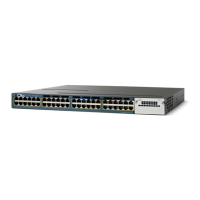1-11
Catalyst 3750-X and 3560-X Switch Software Configuration Guide
OL-25303-03
Chapter 1 Configuring IPv6 Unicast Routing
Understanding IPv6
• DHCPv6 Bulk-Lease Query
DHCPv6 bulk-lease query allows a client to request information about DHCPv6 bindings. This
functionality adds new query types and allows the bulk transfer of DHCPv6 binding data through
TCP. Bulk transfer of DHCPv6 binding data is useful when the relay server switch is rebooted and
the relay server has lost all the binding information. After the reboot, the relay server automatically
generates a bulk-lease query to get the binding information from the DHCP server.
• DHCPv6 Relay Source Configuration
The DHCPv6 server replies to the source address of the DHCP relay agent. Typically, messages from
a DHCPv6 relay agent show the source address of the interface from which they are sent. You can
use the DHCPv6 relay source configuration feature to configure a more stable address (such as a
loopback interface) as the source address for messages from the relay agent. You can configure the
source address globally for the switch or for a specific interface. An address configured on an
interface takes precedence over one configured globally.
For more information and to configure these features, see the Cisco IOS IPv6 Configuration Guide,
Release 12.4.
This document describes only the DHCPv6 address assignment. For more information about configuring
the DHCPv6 client, server, or relay agent functions, see the “Implementing DHCP for IPv6” chapter in
the Cisco IOS IPv6 Configuration Library on Cisco.com.
Static Routes for IPv6
Static routes are manually configured and define an explicit route between two networking devices.
Static routes are useful for smaller networks with only one path to an outside network or to provide
security for certain types of traffic in a larger network.
For more information about static routes, see the “Implementing Static Routes for IPv6” chapter in the
Cisco IOS IPv6 Configuration Library on Cisco.com.
RIP for IPv6
Routing Information Protocol (RIP) for IPv6 is a distance-vector protocol that uses hop count as a
routing metric. It includes support for IPv6 addresses and prefixes and the all-RIP-routers multicast
group address FF02::9 as the destination address for RIP update messages.
For more information about RIP for IPv6, see the “Implementing RIP for IPv6” chapter in the Cisco IOS
IPv6 Configuration Library on Cisco.com.
OSPF for IPv6
The switch running the IP-services feature set supports Open Shortest Path First (OSPF) for IPv6, a
link-state protocol for IP. For more information, see the “Implementing OSFP for IPv6” chapter in the
Cisco IOS IPv6 Configuration Library on Cisco.com.
OSPFv3 Graceful Restart
Beginning with Cisco IOS Release 12.2(58)SE, switches running the IP services feature set support the
graceful restart feature in OSPFv3. This feature allows nonstop data forwarding along known routes
while the OSPFv3 routing protocol information is restored. A switch uses graceful restart either in restart
mode (for a graceful-restart-capable switch) or in helper mode (for a graceful-restart-aware switch).

